
(ESA-C. Carreau/ATG Medialab)
Two decades of planning by the Fermi Institute’s Tom Economou culminate in a comet landing.
Even as Tom Economou approached retirement age in 1994, he began planning an instrument for the European Space Agency’s Rosetta mission to a comet. He still remembers the reaction of Riccardo Levi-Setti, then director of the University of Chicago’s Enrico Fermi Institute, after the latter reviewed the mission timeline, which culminated with a comet rendezvous in 2014.
“Riccardo looked at me and said, ‘Let’s see, 1994, 2014. Where do you think Tom will be in 2014?’
“Well, of course I expect to be here,” replied Economou, who at age 77 is still a Fermi Institute senior scientist. Economou’s work came to fruition on November 12, when a robotic lander called Philae, having detached from the main Rosetta craft, touched down on the head of the snowman-shaped comet 67 P/Churyumov-Gerasimenko. Among Philae’s instruments is the alpha particle X-ray spectrometer (APXS) that Economou successfully proposed.
After a journey of 10 years and more than 3.7 billion miles, Rosetta and Philae are poised to deliver new insights into how our solar system evolved and whether comet impacts helped form Earth’s oceans and brought chemical precursors of life. The APXS detects alpha particles and X-rays. Of the Philae’s 10 instruments, it is the only one that can provide information about the elemental composition of the comet’s surface.
Other UChicago scientists following the rendezvous with interest are Thomas Stephan, a senior scientist in geophysical sciences, and Nicolas Dauphas, professor in geophysical sciences.
Stephan is a member of the team analyzing data collected by Rosetta’s dust analyzer. While working at the Westfälische Wilhelms-Universität Münster in Germany, Stephan helped build and prepare Rosetta’s COSIMA (Cometary Secondary Ion Mass Analyzer). In Germany and later at UChicago, he also analyzed dust samples returned from comet Wild 2 by the Stardust spacecraft.
Although not directly involved in the mission, Dauphas operates UChicago’s Origins Laboratory, which examines questions pertaining to the formation of these solar system objects. “It’s interesting to see what comets are made of because they could have played a role in seeding life on Earth by bringing in some specific organic molecules that were in the primitive soup of the early oceans,” Dauphas says.
Rosetta was originally scheduled to launch in 2003 for a rendezvous with Comet 46 P/Wirtanen, but problems with the probe’s Ariane rocket caused a delay. By the time Rosetta successfully launched on March 2, 2004, Economou had almost forgotten about it. Since submitting his proposal for the APXS, he had become busy with four other robotic interplanetary space missions.
Economou built the APXS that performed the first chemical analysis of martian rocks aboard the Mars Pathfinder rover in 1997. The two Mars Exploration Rovers that landed on Mars in January 2004, Spirit and Opportunity, carried APXSs similar to Pathfinder’s chemical sensor. The Spirit rover operated for six years, while Opportunity has traveled 26 miles “and it’s still going strong,” Economou says.
The Cassini mission to Saturn carries the high rate detector that Economou helped develop along with the late John Simpson, the Arthur Holly Compton Distinguished Service Professor Emeritus in Physics, and the late Anthony Tuzzolino, SM’55, PhD’57, a senior scientist in the Fermi Institute. The high rate detector measures the dust particles that orbit Saturn and its moons, including Enceladus.
Economou also participated in the Stardust mission, which flew within 150 miles of comet Wild 2 in January 2004 with the Simpson group’s dust flux monitor instrument. The instrument collected data on the microscopic dust particles streaming from the comet. After that mission, the spacecraft was redirected to another comet encounter during the Stardust-NExT mission in 2011.
Philae’s APXS is a descendant of the alpha backscattering experiment developed by the late Anthony Turkevich, the James Franck Distinguished Service Professor Emeritus in Chemistry, for pre-Apollo lunar studies in the 1960s. Economou collaborated with Turkevich for 38 years. The APXS was designed to measure the number of atoms of light elements—such as carbon, oxygen, and nitrogen—on the comet’s surface. “That’s what a comet is,” Economou says. “It’s half ice and half dust.”
Some of the lander’s other instruments took measurements revealing that the comet’s water is chemically different from that on Earth, complicating a long-held idea that comets provided water to the oceans early in Earth’s history.
Dauphas is especially interested in the noble gas content of comets. These highly stable gases, which include helium, neon, and argon, could offer clues about the formation of Earth’s atmosphere.
“The composition of the atmosphere is puzzling. We cannot relate it easily to any of the building blocks of the Earth,” Dauphas says. “When we look at meteorites, there is nothing that really matches the composition of Earth’s atmosphere. Comets are one category of objects that we have never measured.”
